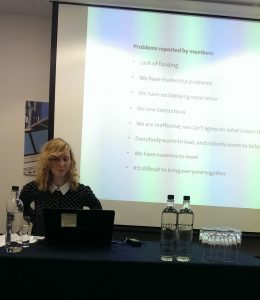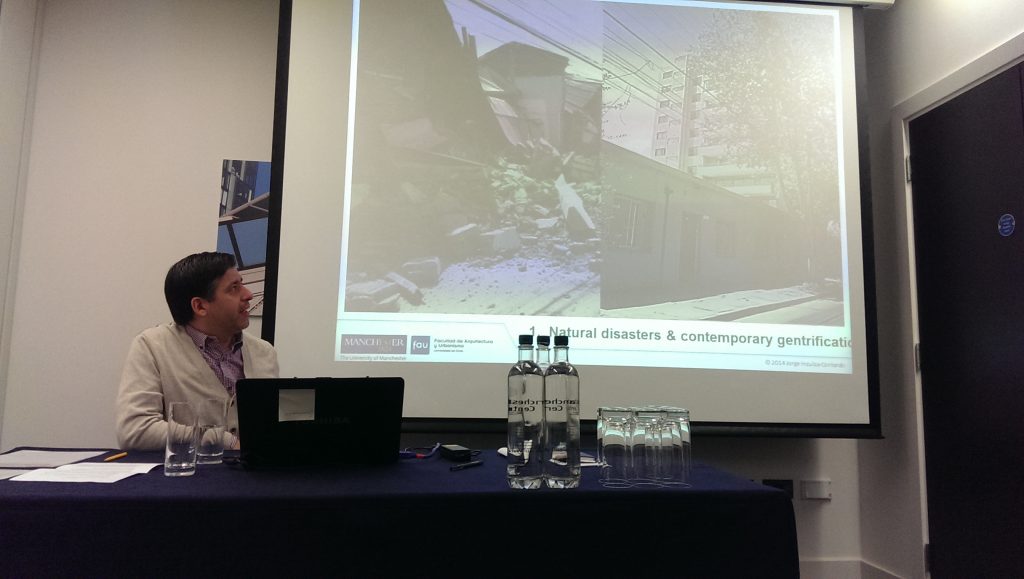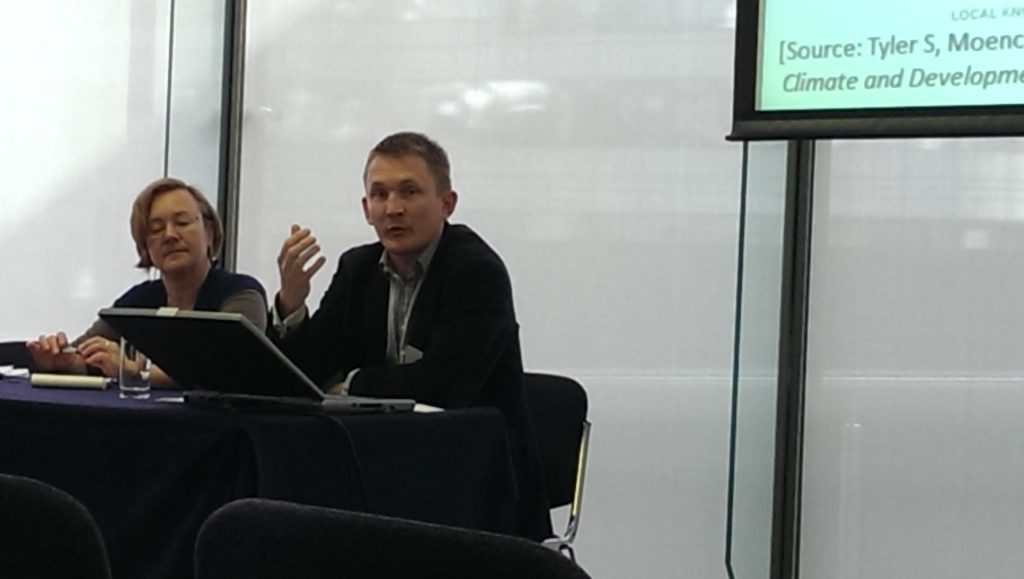International Conference on Urban Health 2014 Day 3
Of refugees and post-earthquake responses
The third part of the series Ambivalence in the city at the HCRI/GURC sub-conferences for the 11th International Conference on Urban Health continued with the session Urban humanitarianism III: Refugees, inequalities and humanitarianism. Participating in the plenary was our colleague Cathy Wilcock, from IDPM at the University of Manchester, and Jorge Inzulza from the University of Chile.
 Cathy Wilcock started the session with the presentation Institutional Resistance to the transnational political activities of refugee groups: The anti-politics of refugee NGOS towards Sudanese activists in Manchester. Cathy explores how the political activities of Sudanese refugees in urban centres in the UK are affected by the political environment of their new place of residence. She analyses the systems of power relations, both actors and processes, of the refugees political environment in relation to their transnational activities. She does this by exploring three key questions: What transnational activities are taking place? How do UK-NGOs relate to those activities? And, what are the implications of this relation?
Cathy Wilcock started the session with the presentation Institutional Resistance to the transnational political activities of refugee groups: The anti-politics of refugee NGOS towards Sudanese activists in Manchester. Cathy explores how the political activities of Sudanese refugees in urban centres in the UK are affected by the political environment of their new place of residence. She analyses the systems of power relations, both actors and processes, of the refugees political environment in relation to their transnational activities. She does this by exploring three key questions: What transnational activities are taking place? How do UK-NGOs relate to those activities? And, what are the implications of this relation?
In this context, refugees NGOs aim to support and empower communities to establish strong organizations; nonetheless, these NGOs appear to be extremely concerned with the possibility of lending support to political activists based in the UK, such as the anti-Bashir movement. As a result, political activism is seen by NGOs as a menace for the refugees community development and an institutional resistance emerges whereby NGOs become reluctant to form relationships with transnational political activism groups. Additionally, an obvious support for cultural, as opposed to political refugee organisations, on one hand, and resistance to political activities on the other, sends the message that There is an ideal type of refugee that we will support, namely those who are victims of conflict, and not embroiled in the contentious politics which espoused conflict, those who bring over cultural memories of their place of origin and not political ones. In short, it results in the legitimisation of cultural activities and the delegitimisation of political activities. She asks whether, in reality, it is sensible or possible for those to be separated.
 To continue with the session, Jorge Inzulza, from the University of Chile presented a very engaging topic; Tremors and large waves: loss of memories and threat in the context of the Chilean reconstruction. Dr Inzulza introduced the urban planning policies issues regarding post-earthquake reconstruction using the case of Talca and Constitucion. He argued that, natural disasters and gentrification are processes that commonly increase poverty and social inequality; they often displace residents and change the urban landscape in cities, particularly at intermediate size cities in Latin America. Dr Inzulza suggested that, the lack of appropriate post-reconstruction planning policies results in a gentrification of the city, where the loss of infrastructure and consequent sense of place amounts to the loss of citizens legitimacy and identity. He highlighted the dissonance between the existent normative and guideline documents that work at different levels and the pressing needs that surge from the earthquake; and there is an explicit disconnection between normative aspects and socio-economic, government management, territorial investments and a spatial-physical approach to planning for reconstruction.
To continue with the session, Jorge Inzulza, from the University of Chile presented a very engaging topic; Tremors and large waves: loss of memories and threat in the context of the Chilean reconstruction. Dr Inzulza introduced the urban planning policies issues regarding post-earthquake reconstruction using the case of Talca and Constitucion. He argued that, natural disasters and gentrification are processes that commonly increase poverty and social inequality; they often displace residents and change the urban landscape in cities, particularly at intermediate size cities in Latin America. Dr Inzulza suggested that, the lack of appropriate post-reconstruction planning policies results in a gentrification of the city, where the loss of infrastructure and consequent sense of place amounts to the loss of citizens legitimacy and identity. He highlighted the dissonance between the existent normative and guideline documents that work at different levels and the pressing needs that surge from the earthquake; and there is an explicit disconnection between normative aspects and socio-economic, government management, territorial investments and a spatial-physical approach to planning for reconstruction.
This was indeed a very compelling and exciting session. Thanks to both participants!!
All change please: climate in urban areas
The third day of the conference ICUH 2014, started with a plenary session led by Prof Hancock, Prof Sir Gilmore, Prof Hickman and Prof Rao. First, Prof Hancock presented the impacts of climate change on urban areas. Pointing out the three parameters that have influence on urban areas and public health (environment, people and economy), he argued for the need for healthy democracies. Secondly, Prof Sir Gilmore introduced the disastrous effects of alcohol on urban population. Hence, he claimed that we are currently witnessing a shift of the behaviour of the population: from enjoying a glass of alcohol to binge drinking. This change poses a serious threat for public health as a significant increase in alcohol-related injuries and disease and death is observed. Then, the third speaker, Prof Hickman, talked about the issue of hepatitis C in urban areas among the injection users with a very cost/effective approach by addressing the effectiveness of the possible interventions depending on the prevalence of the disease among this population. The last speaker, Prof Rao, described the health problems of the urban poor in Indian and Bangladesh cities. She pointed out the link between health and urbanisation emphasising the importance of the urban areas. Indeed, cities are powerful drivers of economic growth, but they are also the witnesses of social inequity between low-income and higher-income communities, being a major issue to address.
Is climate change THE PRIMARY concern or is it a new characteristic of development issues?
The documentary presented by Dr Dodman entitled Climate Bites: Disease, of the hot cities series, was supported by the Rockefeller Foundation for the purpose of being broadcast by the BBC. It presented the exacerbation of public health issues related to climate change. The examples of Jakarta and the increasing epidemics of dengue, Paris and the heat wave which occurred in 2003, and Chicago and its solutions strategies such as green roofs and surveillance system were examined.
This interesting video raises numerous questions. First, the documentary emphasises that climate change is the cause of the public health issues. However, is climate change really the main cause of the disease epidemics, or does it simply exacerbate existent issues of urbanisation of the city? In this case, what is the degree of importance of its impacts on these inherent urbanisation issues? Is climate change a development issue?
Furthermore, the case of Jakarta addresses gender issues. Indeed, while fogging is undertaken by the authorities, prevention campaigns and insecticide distribution are also carried out by a women’s organisation. Hence, could measures to face climate change impacts be implemented along with women’s empowerment strategies? However, while focusing on this organisation, further questions are raised. Who provided the insecticide to the women’s organisation? How was their organisation set up? Would it be efficient in a low-income community, also often lacking of basic knowledge?
In this context, it can also be noted that the strategy implemented by the authorities is short term. It eradicates the vector but it does not address the underlying issue of water and sanitation. Hence, the sustainability of the strategy is questionable as the deeper causes of the epidemics are not addressed. On the contrary, long-term strategies such as the building of green infrastructures and designed of surveillance system of the most vulnerable people have been implemented in Chicago. However, could these long-term strategies of Northern cities be possible to be implemented in the cities of the Global South as these latest are already facing heavy and different urbanisation burdens?
Finally, regarding both the heat wave in Paris and dengue in Jakarta, it can be noticed that the authorities and sanitary actors were unprepared to face the hazards. Learning from these experiences, responses have been elaborated. However, do we need to witness deaths to prepare for the coming changes?
All’s well that ends well: Closing plenary
 The closing session of the HCRI/GURC sub-conferences was chaired by Dr Tanja Muller, with the contributions of Professor Diana Mitlin, from GURC at the University of Manchester and Dr David Dodman from IIED.
The closing session of the HCRI/GURC sub-conferences was chaired by Dr Tanja Muller, with the contributions of Professor Diana Mitlin, from GURC at the University of Manchester and Dr David Dodman from IIED.
Professor Mitlin started by offering her observations on Urban Risk and Humanitarian Response: reflecting on urban realities and specificities, where, in order to understand urban risks, she scrutinized what the terms urban, risks and humanitarian mean. An urban environment is among other things, characterised by high density areas, a dependence on labour markets influenced by public investment management and potential of urban space.
Dr Dodman explored the topic Climate change and its health impacts on the urban poor and pointed at the pressing need for new urban systems for resilience, and to develop preventative measures for the implications of climate change in health.
The session ended as an invigorating exchange of ideas between the audience and the panellists. We discussed the significance of humanitarian response to the current and future challenges posed to urban health, by risks such as violence and climate change.
Overall, the HCRI/GURC sub-conference of the 11th International Conference on Urban Health delivered a thought-provoking and dynamic symposium. It brought together some fascinating research from both established and emerging academics with insights from some world-leading practitioners.


0 Comments